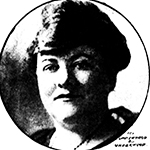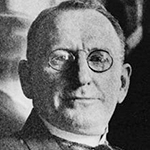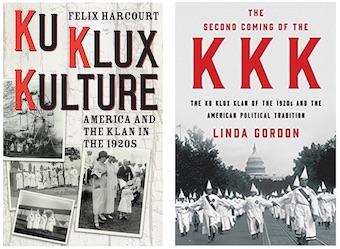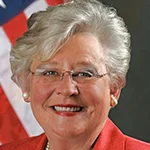 Elizabeth Tyler |
Two PR pros played a major role in the 1915 rebirth of the Ku Klux Klan as a profit-making enterprise, according to an article written by Adam Hochschild in the Dec. 7 New York Review of Books.
In the aftermath of D.W. Griffith's landmark film, "The Birth of a Nation," Atlanta doctor William Simmons reincarnated the KKK, which had largely disbanded in the South under pressure from the federal government during the 1870s.
Two skilled PR professionals, Elizabeth Tyler and Edward Clarke, began advising Simmons in 1920.
"They convinced him that for the Klan to gain members in other parts of the country, it had to add Jews, Catholics, immigrants, and big society elites to its list of villains," wrote Hochschild. "Tyler and Clarke, in effect, ran the KKK for the next several years, a pair of Bannons to Simmons' Trump."
 William Simmons |
The PR duo signed a contract with Simmons, giving them 80 percent of dues and other revenues generated from new recruits.
Hochschild believes they collected $850K from the venture, which translates into $11M today, during their first 15 months on the job.
"Tyler and Clarke polished Simmons' speaking style and set up newspaper interviews for him, gave free Klan memberships to Protestant ministers, and assured prominent placement of their blizzard of press releases by buying tens of thousands of dollars' worth of newspaper advertising," wrote Hochschild.
Corruption led to Simmons' demise as he spent Klan money on horse races, prizefights and booze.
Tyler and Clarke schemed with Simmons' rivals and ousted him from the Imperial Wizard spot.
A Texas dentist, Hiram Evans, took over the Klan in 1922, and with an eye on Tyler and Clarke’s 80 percent cut of the revenues, forced them out with a scandal. The pair was having an affair through each was married to someone else.
 |
Linda Gordon, author of “The Second Coming of the KKK: The Ku Klux Klan of the 1920s and the American Political Tradition," mainly credits Tyler for the KKK rebirth.
"The organization might well have grown without this this driven, bold, corrupt and precociously entrepreneurial woman, but it would likely have been smaller," she wrote.
The KKK moved its headquarters to Washington and membership soared to an estimated 4M by 1924.
Revenue flowed in from the sale of dues, insurance, knives, trinkets and garb.
Made to exacting patterns, KKK robes and painted hoods were sold at a big mark-up and could only be purchased from a company controlled by Clarke until he got the boot.
With Gordon's book, Hochschild also reviewed "Ku Klux Kulture: America and the Klan in the 1920s" written by Felix Harcourt.
His NYRB piece is called "Ku Klux Klambakes."


 Southern governors claim they know what's best for their working class, and it's not pay raises... A Ukrainian human rights group played a key role in convincing House Speaker Mike Johnson to hold a vote to send arms to Ukraine, Israel and Taiwan... Trump Media & Technology Group blames short-selling and not lousy outlook for its stock slump.
Southern governors claim they know what's best for their working class, and it's not pay raises... A Ukrainian human rights group played a key role in convincing House Speaker Mike Johnson to hold a vote to send arms to Ukraine, Israel and Taiwan... Trump Media & Technology Group blames short-selling and not lousy outlook for its stock slump. The techniques deployed by OJ Simpson's defense team in the 'trial of the century' served as a harbinger for those used by Donald Trump... People worry about the politicization of medical science just as much as they fret about another pandemic, according to Edelman Trust Barometer... Book bans aren't restricted to red states as deep blue Illinois, Connecticut and Maryland challenged at least 100 titles in 2023.
The techniques deployed by OJ Simpson's defense team in the 'trial of the century' served as a harbinger for those used by Donald Trump... People worry about the politicization of medical science just as much as they fret about another pandemic, according to Edelman Trust Barometer... Book bans aren't restricted to red states as deep blue Illinois, Connecticut and Maryland challenged at least 100 titles in 2023. The NBA, which promotes legalized gambling 24/7, seems more than hypocritical for banning player for placing bets... Diocese of Brooklyn promises to issue press release the next time one of its priests is charged with sexual abuse... Truth Social aspires to be one of Donald Trump's iconic American brands, just like Trump University or Trump Steaks or Trump Ice Cubes.
The NBA, which promotes legalized gambling 24/7, seems more than hypocritical for banning player for placing bets... Diocese of Brooklyn promises to issue press release the next time one of its priests is charged with sexual abuse... Truth Social aspires to be one of Donald Trump's iconic American brands, just like Trump University or Trump Steaks or Trump Ice Cubes. Publicis Groupe CEO Arthur Sadoun puts competition on notice... Macy's throws in the towel as it appoints two directors nominated by its unwanted suitor... The Profile in Wimpery Award goes to the Ford Presidential Foundation for stiffing American hero and former Wyoming Congresswoman Liz Cheney.
Publicis Groupe CEO Arthur Sadoun puts competition on notice... Macy's throws in the towel as it appoints two directors nominated by its unwanted suitor... The Profile in Wimpery Award goes to the Ford Presidential Foundation for stiffing American hero and former Wyoming Congresswoman Liz Cheney. JPMorgan Chase chief Jamie Dimon's "letter to shareholders" is a must-read for PR people and others interested in fixing America and living up to its potential... Get ready for the PPE shortage when the next pandemic hits... Nixing Netanyahu. Gaza carnage turns US opinion against Israel's prime minister.
JPMorgan Chase chief Jamie Dimon's "letter to shareholders" is a must-read for PR people and others interested in fixing America and living up to its potential... Get ready for the PPE shortage when the next pandemic hits... Nixing Netanyahu. Gaza carnage turns US opinion against Israel's prime minister.


 Have a comment? Send it to
Have a comment? Send it to 
No comments have been submitted for this story yet.